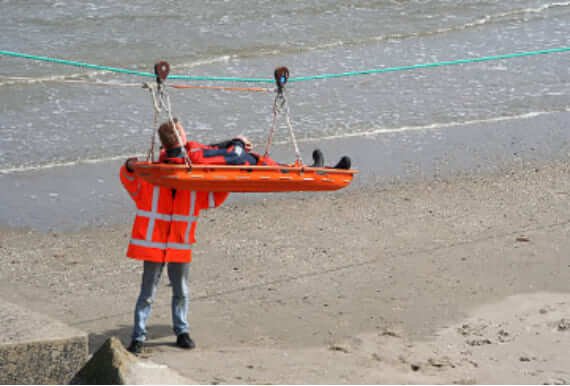The type of stretcher used depends on the casualty’s injuries. Sprains, muscle strains, and fractures are the most common types of injuries that need a stretcher. Only certain stretcher types are suitable for these injuries.
We’ll explain these today.
Ambulance and basket stretchers are the most commonly used. The ambulance stretcher is the most popular of all stretchers. It is the standard stretcher for emergencies. The basket gurney is a specialized stretcher. It is suitable for rescues on uneven surfaces where wheeled stretchers can’t work.
Let’s examine these commonly used stretchers in more detail.
Table of Contents
Toggle1 – The Ambulance Stretcher
The ambulance stretcher is the typical stretcher you’ll find in an ambulance. Paramedics use this stretcher to move a patient from the scene of injury to an ambulance and the hospital.
Features of an Ambulance Stretcher
The ambulance stretcher is manufactured using high-quality aluminum tubes, making it lightweight and strong. It also has a soft cushion for patient comfort during transportation.
The other common features you’ll find in an ambulance stretcher include:
- An adjustable and foldable frame. This feature allows you to raise and lower the patient. The adjustable frame makes your work easy when transferring the patient to a hospital bed. The foldable frame enables you to fit the stretcher into the ambulance. The image below shows the frame folding while getting the casualty into the ambulance.

Alt: paramedics getting a patient to an ambulance
- Wheels. The ambulance stretcher’s wheels allow you to push the stretcher, so you don’t have to carry it.
- Adjustable backrest. This feature allows for the patient’s comfort. You can raise the backrest to an angle of 40 degrees, as shown below:

Alt: paramedics pushing a patient on a stretcher
- Handles. The ambulance stretcher has several handles that allow you to push and guide it.
Safety Tips When Using the Ambulance Stretcher
Safety is critical when using any stretcher. Here are a few tips you should keep in mind when using the ambulance stretcher
Tip #1: Select level ground whenever possible. Choose a path with level ground. An even surface allows for a smooth ride that is comfortable for the patient. It is also the ideal surface for the stretcher’s stability.
Tip #2: Always inspect the wheel and brakes. The wheels and brakes of the gurney wear off after a period of use. Before carrying a casualty, ensure the wheels and brakes are working well. These checks will prevent the ambulance stretcher from rolling away on elevated ground. They will also help prevent cases of your patient sliding and falling.
Tip #3: Assess the patient before placing them on the stretcher. Medical engineers design most stretchers to hold a maximum weight of 159 kilograms. If you suspect the casualty is heavier than this limit, use a bariatric stretcher instead. Observing this tip will enhance your safety and the casualty’s.
Tip #4: One of you must always hold the stretcher’s handles when placing the patient on the stretcher. Hold the handles when pushing the stretcher to an ambulance or transferring the patient to a hospital bed. This is an extra precaution to stop the stretcher from slipping away. You can let go of the handles once you ensure the stretcher is well secured.
2 – The Basket Stretcher
The basket stretcher is ideal when the rescue mission requires significant walking. The stretcher can also work when the passageway is too small to walk through.
Features of a Basket Stretcher
The basket stretcher has a stainless steel frame covered by an HDPE shell. The frame enables the stretcher to support the patient’s weight. It also makes it strong enough to withstand impact and abrasion during plane sliding. You’ll notice the strong frame from this older model of a basket stretcher:

Alt: crane raising a basket stretcher
Basket stretchers have four safety belts to help secure the patient during movement. One belt restrains the casualty’s chest. The other secures the pelvic areas while two secure the legs.
It is shaped like a basket to protect the area below and beside the patient from abrasion and impact during movement.
The basket stretcher has handholds all around it that allow you to hold it from multiple positions during difficult rescues. These gurneys have four special metallic rings that enable you to raise the patent to a helicopter hovering above.
The standard basket stretcher weighs about 18 kilograms. You can use it to carry a maximum patient weight of 159 kilograms. Some bariatric models are wider, longer, and can support up to a ton of weight.
Safety Precautions When Using the Basket Stretcher
Emergencies that require a basket stretcher present many safety risks. These precautions will help move your casualty safely during the rescue mission.
- Always ensure the patient’s weight is well-balanced. You will find it easier to maneuver rugged terrains if the casualty’s weight is distributed uniformly. Proper balance makes rescues over inclined surfaces, such as the one shown below, safe:

Alt: paramedic pushing a basket stretcher suspended on ropes
- Ensure the casualty is well secured when performing a helicopter rescue. Helicopter rescues are done using four slings. You’ll notice two long yellow ones and two short blue ones. Secure the upper body using the blue straps and the lower body using the yellow ones.
- Always ensure you have enough personnel to operate the basket stretcher. Unlike the ambulance stretcher, which one person can push, you must carry the basket stretcher. A minimum of two people must carry the patient on the stretcher. You may need additional help if the patient is heavy.
Conclusion
Ambulance and basket stretchers are the most commonly used stretchers. Paramedics use the ambulance stretcher for standard rescues where they can push the stretcher. The basket stretcher is used for difficult rescues where you must carry the patient or perform a helicopter rescue.
Frequently Asked Questions
Why are there different types and designs of stretchers?
There are different types of stretches because emergencies are never the same. The ambulance stretcher can help transport a patient in most emergencies, but you’ll need a specialized stretcher for complicated rescues. Examples of specialized stretchers are the basket, sine board, and scoop stretchers.
Why do ambulance stretchers have wheels?
The ambulance stretcher has wheels because you are supposed to push it, not carry it. The wheels allow you to move the patient over an even or paved surface.
What makes a basket stretcher versatile?
The steel frame and HDPE outer shell of the basket stretcher make it versatile. These materials allow the stretcher to withstand significant abuse during rescue missions.



